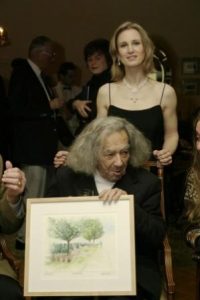 On October 3, 2006 shortly after the poet died, the City of Toronto honoured George Faludy, one of Hungary’s greatest poets and longtime resident of Toronto, at a ceremony to name a public space George Faludy Place. The space is located across from 25 St. Mary St. where Mr. Faludy lived for much of his 22 years of self-imposed exile from Hungary. Mr. Faludy was planning to return to Toronto for the ceremony but died in Budapest on September 1, at age 95.
On October 3, 2006 shortly after the poet died, the City of Toronto honoured George Faludy, one of Hungary’s greatest poets and longtime resident of Toronto, at a ceremony to name a public space George Faludy Place. The space is located across from 25 St. Mary St. where Mr. Faludy lived for much of his 22 years of self-imposed exile from Hungary. Mr. Faludy was planning to return to Toronto for the ceremony but died in Budapest on September 1, at age 95.
“We celebrate George Faludy as a great poet and a man of great courage in the face of terrible oppression,” said Rita Davies, Executive Director of Toronto Culture. “Imagine having the mental toughness and agility to compose poems while being held in a political concentration camp and committing them to memory as George Faludy did.”
George Faludy arrived in Toronto with an international reputation in 1967 and became a Canadian Citizen in 1976. Mr. Faludy often wrote on the virtues of Canada, remarking that Canada gave him liberty and freedom. He published several books of poetry in translation and influenced many writers during his stay in Canada.
George Faludy Place, designed by Scott Torrance, reflects in its classical proportions and choice of colours (red, white and green of the Hungarian flag) the dominant themes of Faludy’s poetry: the arts of classical civilization and Hungary itself. A plinth in the centre of the parkette bears a bronze medallion of Faludy’s profile created by Dora de Pedery-Hunt. Three other plaques in George Faludy Place complement the plinth: a Heritage Toronto commemorative plaque, Faludy’s poem Michelangelo’s Last Prayer, and a Toronto Legacy plaque bearing the name George Faludy Place.
“Michelangelo’s Last Prayer,” is Andrea Jarmai’s translation of the Faludy sonnet which was inscribed on the bronze plaque at George’s request. It has been published in Volume II of the two-volume anthology In Quest of the Miracle Stag, (ed. Adam Makkai); in Brother to Dragons, Companion to Owls, published by Seraphim Editions, 2004 (Andrea’s own first book-length collection of poems); and, in the chapbook Faludy in English: Translations from the Poems of George Faludy by John Robert Colombo, Andréa Jarmai and George Jonas, published by The Friends of George Faludy in North America, 2005.
George Faludy Place is one of a series of naming projects initiated by Toronto’s first Poet Laureate, Dennis Lee. Under the auspices of Toronto Culture, the Legacy Project honours notable artists, scientists and thinkers who have enriched the life of Toronto by embedding their names in the fabric of the city. Dennis Lee states, “The Legacy Project provides a living heritage of those who came before us and achieved great things. It will enrich the city for generations to come.”
The University of Toronto has partnered with the City of Toronto and the Toronto Legacy Project in the creation of George Faludy Pace and will maintain the parkette on behalf of the City.
The naming ceremony also coincides with the 50th anniversary of the Hungarian Uprising of 1956, that brought 37,000 Hungarians to Canada.

Canadian Embassy in Hungary celebrates George Faludy – Summer 2006
At a reception to honour him, Ambassador Robert Hage commended Faludy’s literary accomplishments and his contribution to the enrichment of Canada’s cultural life.
 The reception also offered an opportunity for Grace Westcott, Co-chair of the Toronto Legacy Project, to present to the 95-year-old poet an original watercolour painting of the landscape design for George Faludy Place, Toronto, which is due to be completed this summer. The parkette’s centrepiece will be a bronze medallion mounted on a plinth, bearing Faludy’s profile which was designed by Dora de Pedery-Hunt, an internationally-known sculptress and friend of the poet.
The reception also offered an opportunity for Grace Westcott, Co-chair of the Toronto Legacy Project, to present to the 95-year-old poet an original watercolour painting of the landscape design for George Faludy Place, Toronto, which is due to be completed this summer. The parkette’s centrepiece will be a bronze medallion mounted on a plinth, bearing Faludy’s profile which was designed by Dora de Pedery-Hunt, an internationally-known sculptress and friend of the poet.
In her speech, Ms. Westcott recalled that the voices of Canadian literature speaks in many accents. “One of those accents is Hungarian, and one of those voices, George Faludy,” she said, pointing out that Faludy belongs to Budapest and Toronto both.
In his recollection of memories from Canada, Faludy said that “I have never in my life felt to be as free as in Canada.” He lived in half a dozen countries throughout his life.
The George Faludy Place will be located opposite the apartment at 25 St. Mary St. where Faludy lived during his Toronto years. This is the second designation made by the Toronto Legacy Project following the renaming of a downtown square after Oscar Peterson, Canada’s great jazz legend.
